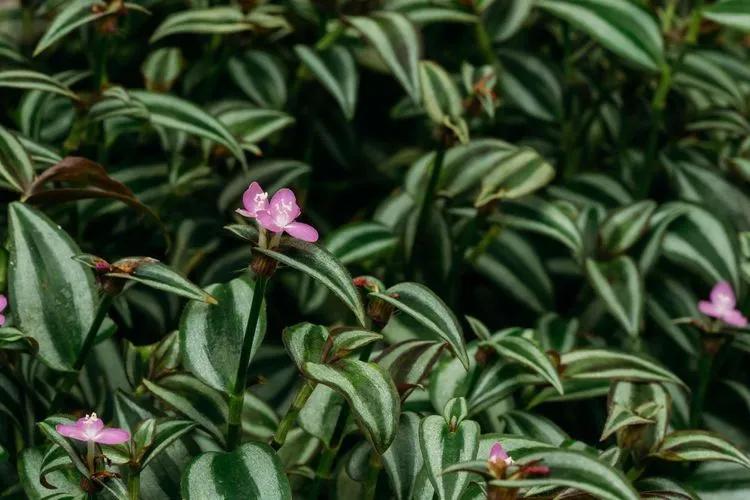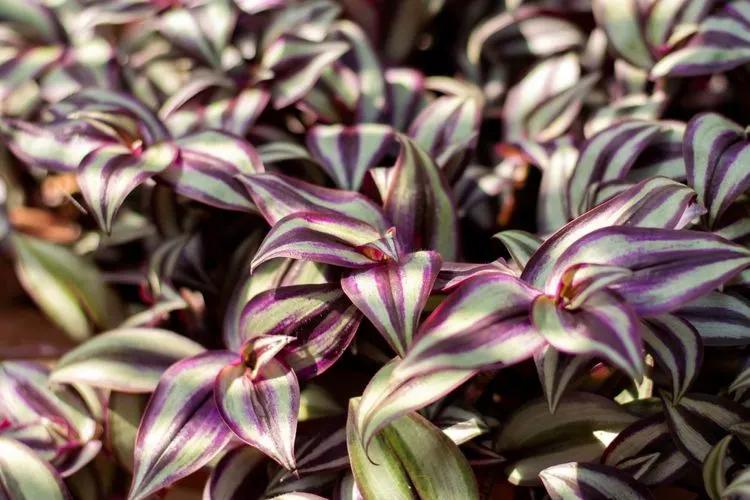Meet inchplant, an iconic indoor plant. Shown off proudly in a hanging basket, this wild soul is very forgiving, making it a perfect green companion. Some say it even used to be a housewarming gift: it grows quickly, so a handful of stem cuttings was sure to cover the new household with greenery. Read on to see whether it really is as independent as they say, and what are the ways to enjoy having it in your home.
Overview
 The common names given to the Tradescantia zebrina reveal a lot about its nature - Wandering Jew (Wandering Dude?), spiderwort, or inchplant. In Spain, however, they call it Saint Lucy's plant - particular chemicals are used in the eye drops, and this saint is known to have been able to restore sight and spread light. An inchplant implies there's only an inch needed to propagate the plant. Or that it grows an inch every week! There are lighter and darker variegated species within the Wandering Jew family. Since inchplant lives relatively little and tends to get unruly, some call it invasive. Here's where you can step in and provide a careful watch - so that there's mutual respect between you!
The common names given to the Tradescantia zebrina reveal a lot about its nature - Wandering Jew (Wandering Dude?), spiderwort, or inchplant. In Spain, however, they call it Saint Lucy's plant - particular chemicals are used in the eye drops, and this saint is known to have been able to restore sight and spread light. An inchplant implies there's only an inch needed to propagate the plant. Or that it grows an inch every week! There are lighter and darker variegated species within the Wandering Jew family. Since inchplant lives relatively little and tends to get unruly, some call it invasive. Here's where you can step in and provide a careful watch - so that there's mutual respect between you!
Watering
Keep your tradescantia zebrina watering regime on the easier side; this plant tolerates short-term droughts better than overwatering. Keep the soil only slightly moist during warmer seasons and cut back on the water volume in winter: excessive moisture doesn't help the growth and may stagnate. As many hanging plants do, an inchplant enjoys regular misting. But watch out not to splash the foliage directly when watering to avoid bacterial infections and rotting.
Temperature
Tradescantia zebrina care can be conducted under colder conditions, relatively rare among houseplants. Even an average temperature of just 50˚F (15˚C) will do fine. However, cold drafts and frosts are still to be avoided, as well as irregular temperature swifts. This causes unnecessary stress, and you might notice the leaves getting weaker and developing a yellow hue.
Lighting
Light for tradescantia zebrina directly impacts the lushness and the vibrancy of the variegated foliage. Keeping them in the shade is fine when it comes to health, but if esthetics matter to you, provide a few hours of exposure to bright sunlight a day. You'll notice the positive changes quickly. Do this gradually; there is no need to stress the plant with irregularities. If you see dry tips developing, this indicates sunburns. An inchplant flower is not a too common occurrence, but it is again correct and sufficient light that may make it real. The flowers are violet, spiky yet delicate.
Repotting and propagation
 The growth dynamics of the plant sometimes make you think it's asking to be repotted. An easier way will be to propagate the inchplant. Make a few stem cuttings using sterilized utensils and put them in water. In a week or so, when you see new roots forming, plant your new babies in the soil. The inchplant care guidelines don't call for a particular potting soil mix; a regular one will do. Just make sure it's well-draining. Repot the plant every three years or if you see the signs of roots getting cramped.
The growth dynamics of the plant sometimes make you think it's asking to be repotted. An easier way will be to propagate the inchplant. Make a few stem cuttings using sterilized utensils and put them in water. In a week or so, when you see new roots forming, plant your new babies in the soil. The inchplant care guidelines don't call for a particular potting soil mix; a regular one will do. Just make sure it's well-draining. Repot the plant every three years or if you see the signs of roots getting cramped.
Other recommendations
-
The juicy leaves retain a lot of moisture, just like leaves in succulents do, so usually, there's no need to worry about low humidity. If you know your room to be excessively dry, mist the plant regularly, keep it in the kitchen, or consider using a humidifier.
-
Some types of the wandering jew plant are toxic to pets, in particular, the sap inside the stems, so beware of the possible contact and reach out to the vet in case it happens.
-
You can grow differently variegated species in one pot if you like the sight of it. Just make sure there's enough ventilation and all the other requirements are met.
-
Tradescantia zebrina will appreciate you slightly feeding it during the growth phase, but stop the procedure before the dormant phase as this will do more harm than good.
Pests and common diseases

-
The tradescantia zebrina indoor care sometimes may include dealing with pest infections. Your inchplant might suffer from those should there be a lack of ventilation, overwatering, or high humidity combined with poor sunlight. Should you notice pests on your plant, wash them away with water, get rid of damaged stems and leaves.
-
If you notice the leaves fading, getting softer, and going yellow - this may be either due to overwatering or cold stress. Check your watering routine and the soil; root rot is not uncommon in this plant.
-
Inchplants growing near the vents and radiators tend to get scorching of the leaves, wilting, and crispy edges. Find a better spot for such plants, remove the damaged leaves and slightly increase the watering and misting for a while.
-
Sometimes due to the lush foliage, it's hard not to splash the leaves with water. This may cause bacterial infection, so try to water the plant closer to the roots.
The Wandering Jew plant can become a valuable part of your green family - you can count on its survivability even when other plants let you down. Hanging a pot or two with these beautifully patterned plants is sure to make things brighter in your household.
